Back-to-school activities – Great 2025 ideas and resources
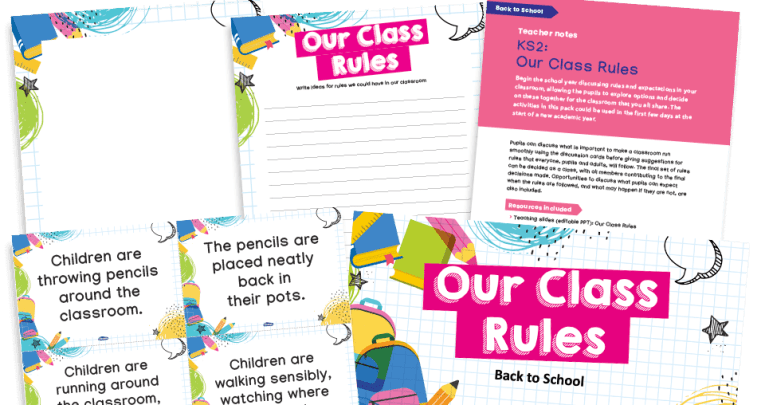
From icebreakers and getting-to-know-you activities to behaviour tips and starter ideas, here’s everything you need to kickstart the new school year…

- by Teachwire
- Classroom expertise and free resources for teachers
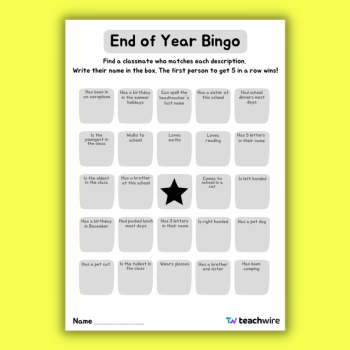
Whether you want to get organised before the holidays even start, or are lamenting the fact that they’re nearly over already, try adding some of these back-to-school activities and ideas to your teaching repertoire before the September term kicks in…
(If you’re looking for end-of-year activities, find them here for primary and here for secondary).
Table of contents
Back-to-school activities for primary
Back-to-school bingo
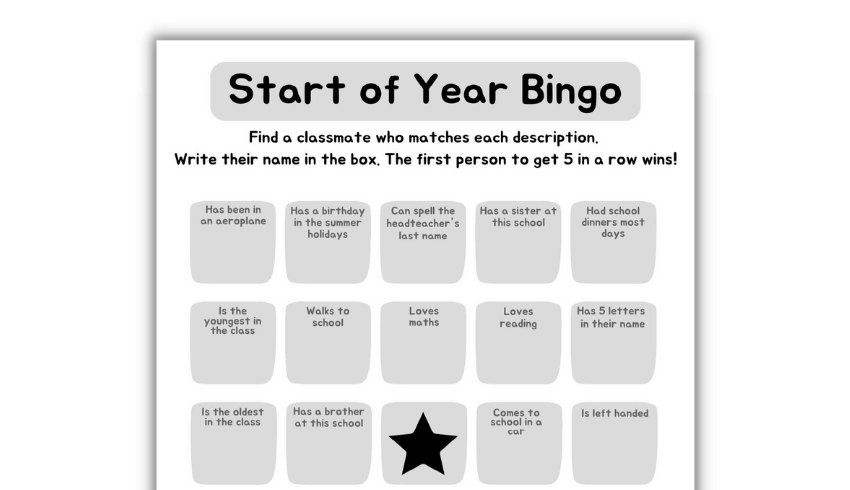
Help your new class get to know each other with this fun back-to-school bingo game. The aim is to fill up the whole board bingo board, while also getting to know your new classmates better!
Back to school activities from Plazoom
Literacy resources website Plazoom has a range of lovely back-to-school activities and resource packs that you can download.
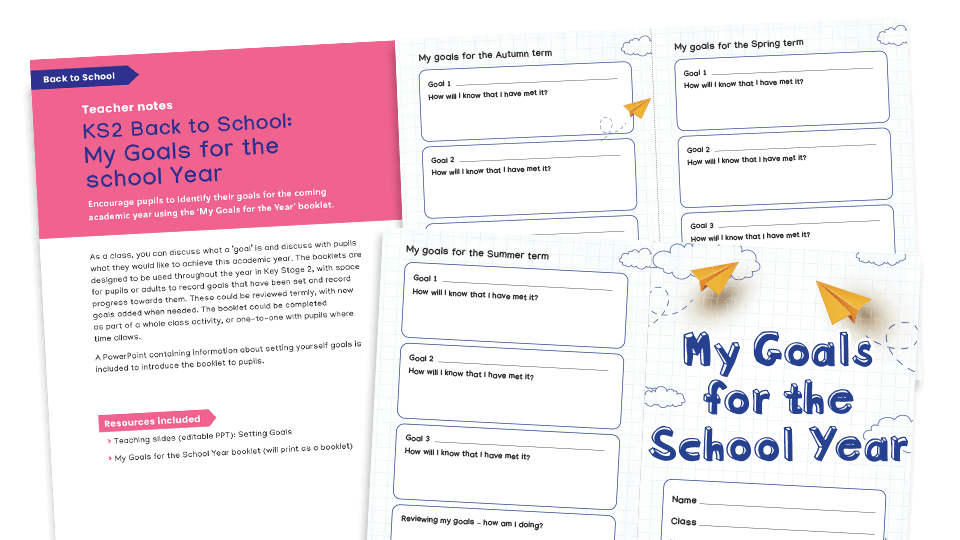
Use this free KS2 resource pack to encourage students to set their goals for the upcoming year. You get a PowerPoint, printable booklet and teacher notes.
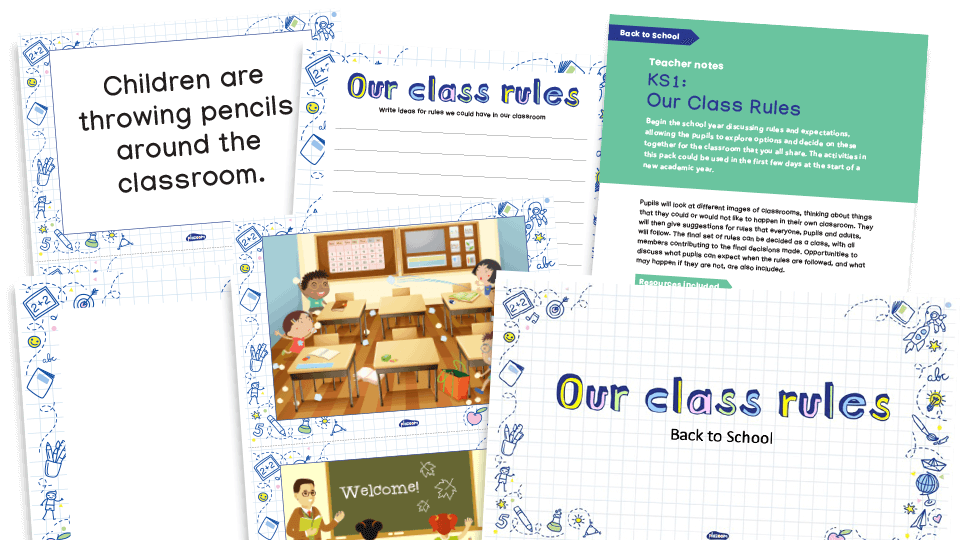
If you teach KS1, this oracy and worksheet pack is all about your new class rules. It comes with teaching slides, image cards, worksheets, teaching notes and more.
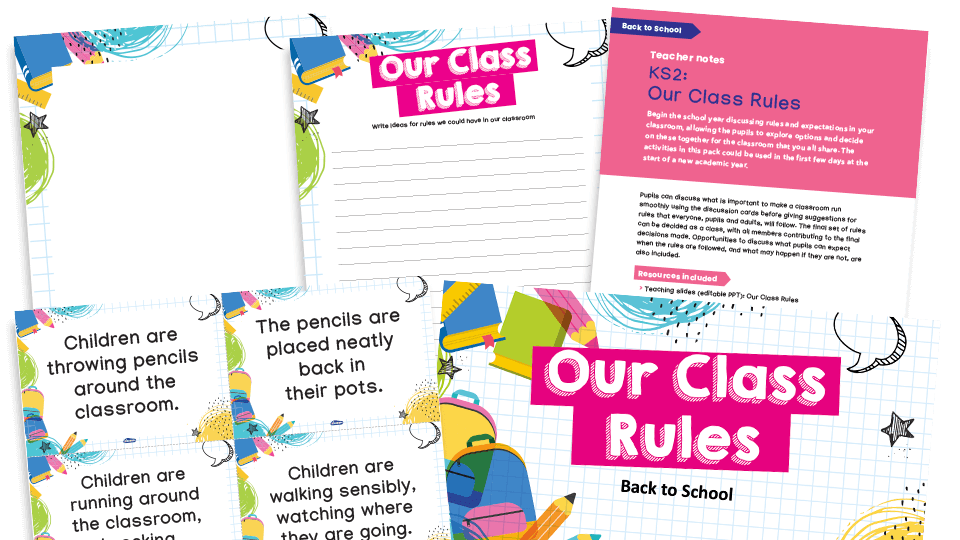
There’s also a similar pack aimed at KS2, allowing you to pin down rules and expectations as a class.
Browse all of Plazoom’s back-to-school collection.
Back-to-school activities for KS2
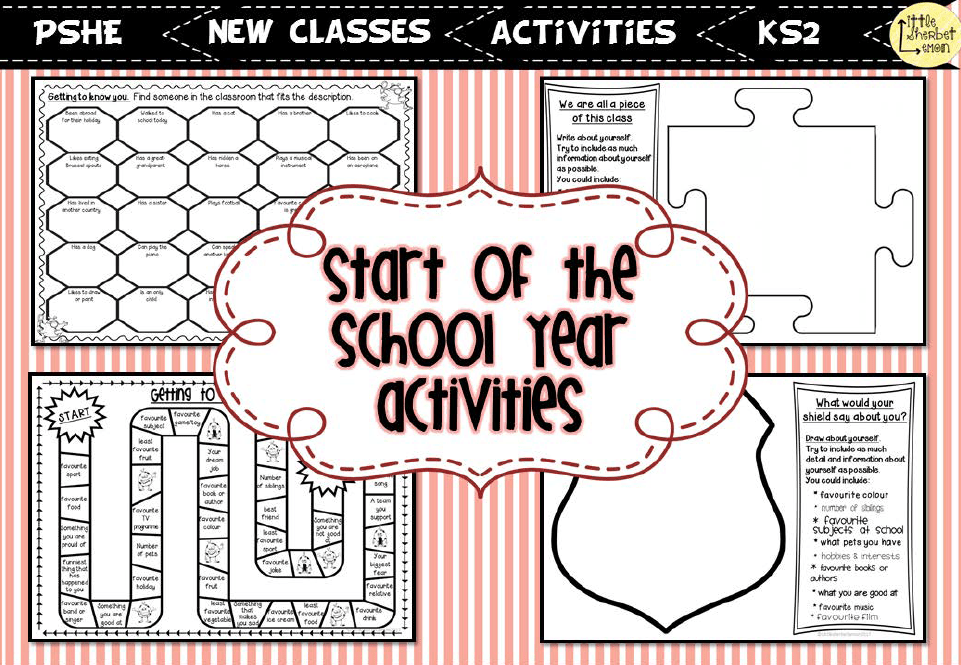
Get your new class to learn about each other with these four back-to-school activities for KS2. Included are:
- ‘Getting to know you’ grid
- ‘Getting to know you’ game
- An activity where each student writes and draws about themselves for a class display
- ‘We are all part of this class’ activity where students’ individual puzzle pieces of their personality are weaved together
Brush up on your behaviour management
Want to refresh your behaviour management skills ready for your new class? Here, expert Sue Cowley explains how to quickly get your class focused and paying attention. Watch more behaviour videos from Sue here.
Personality islands activity
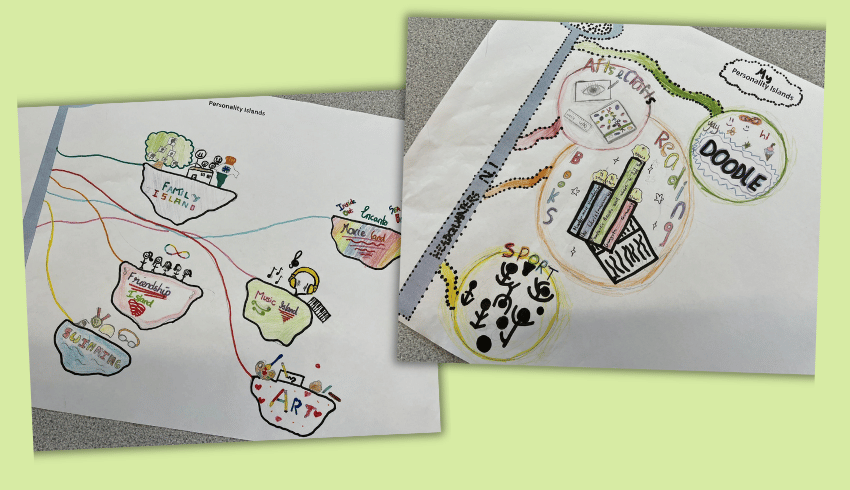
Get to know your pupils better with this personality islands activity, inspired by the film Inside Out…
This task helps children spotlight the core elements that make up who they are. Through sharing and discussion, pupils explore their unique traits and hobbies, giving them a powerful tool for self-expression as they transition into a new school year.
It also creates a platform for meaningful conversations about identity, making this an activity that can be used time and time again, no matter the subject.
1. Watch a clip from Inside Out and discuss the concept of ‘personality islands’. Each island represents an aspect of a child’s personality, such as hobbies, values, or relationships.
2. Encourage pupils to think about what makes them ‘them.’ Discuss examples like family, sports, or art.
3. Next, ask children to draw their own islands. Encourage children to think hard about what they enjoy or love to do, and what is important to them.
4. Add further details, such as symbols or colours that represented their interests or values.
5. Share islands with the class if children feel comfortable doing so. This is an invaluable opportunity for children to communicate what makes them unique. Learning about their peers’ islands encourages a supportive and inclusive class environment.
Karl McGrath, a Year 6 teacher and curriculum task design lead at Benton Park Primary, develops curriculum-driven, engaging task design models.
About Me worksheet
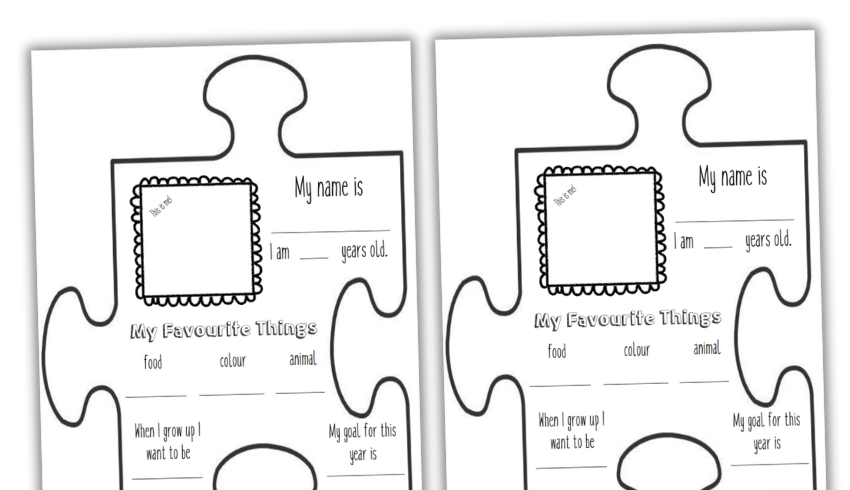
This free About Me worksheet is an excellent activity for children to complete on transition day or at the beginning of the new school year. When they’re done, assemble the completed puzzle pieces into a large, colourful display.
Back-to-school icebreaker lotto for KS1
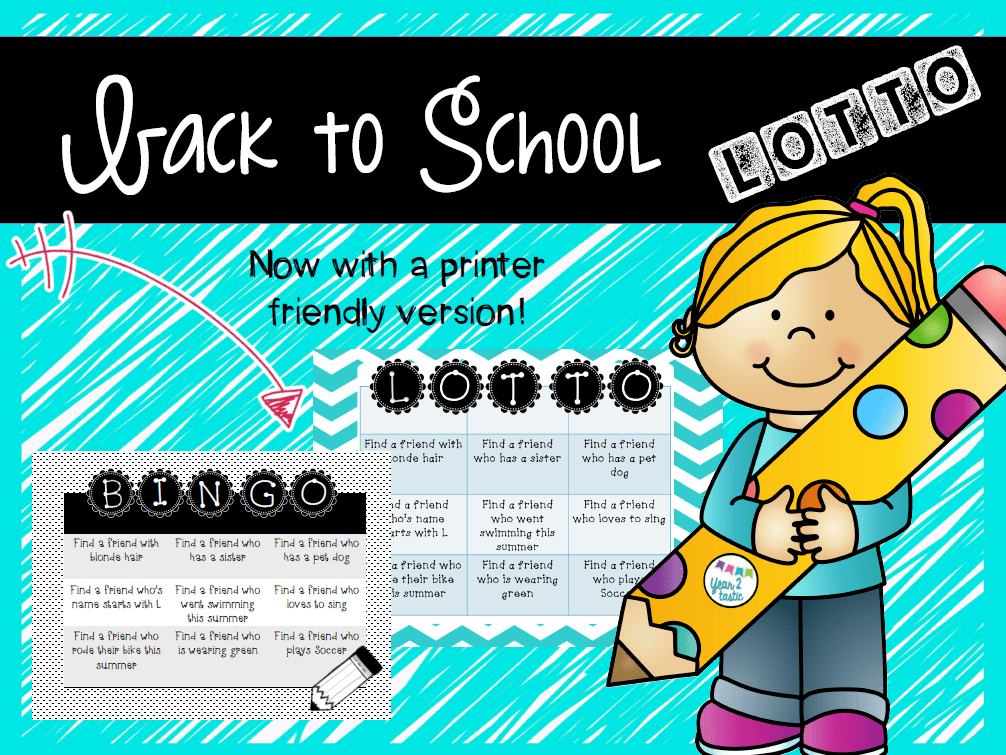
Getting children to chat to each other on the first day back is easy with this free ‘Find a friend who…’ download. Who has a pet dog? Whose name starts with L?
Morning Challenge resources
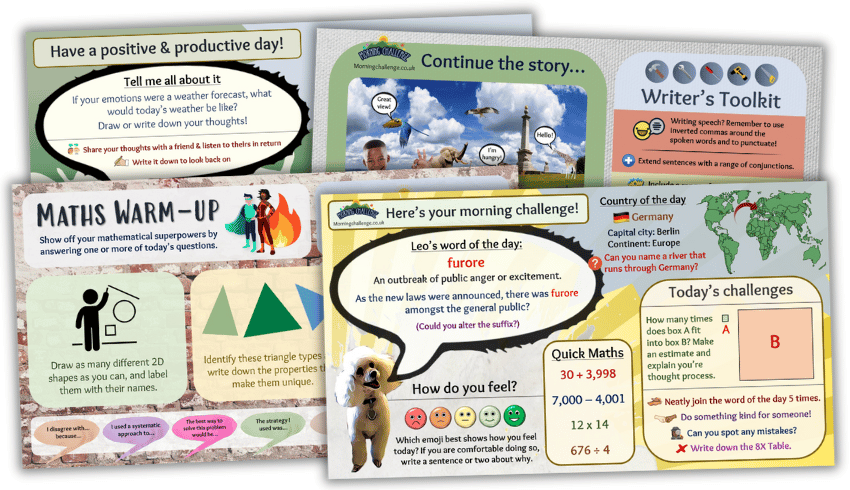
Start the year as you mean to go on by beginning each day with a Morning Challenge. These free sample resources are designed for full-screen viewing on an interactive whiteboard and cover wellbeing, maths, English and more.
New school year song
For the musically inclined, this is a fun song to start a new school year. Use it in assemblies or the classroom. It comes with piano/vocal sheet music, an audio backing track with instrumental melody and a lyrics sheet.
Five icebreakers

Meeting anyone for the first time can be scary. Even as adults, being confronted with a situation where you need to introduce yourself to a stranger is unnerving for most.
Nothing is worse than making a child stand up in front of the entire class and talk about themselves, but icebreakers can be a fantastic way to ease the first-day awkwardness. Here are five icebreaker games that will ensure a smooth start to the school year.
All about me back to school activities
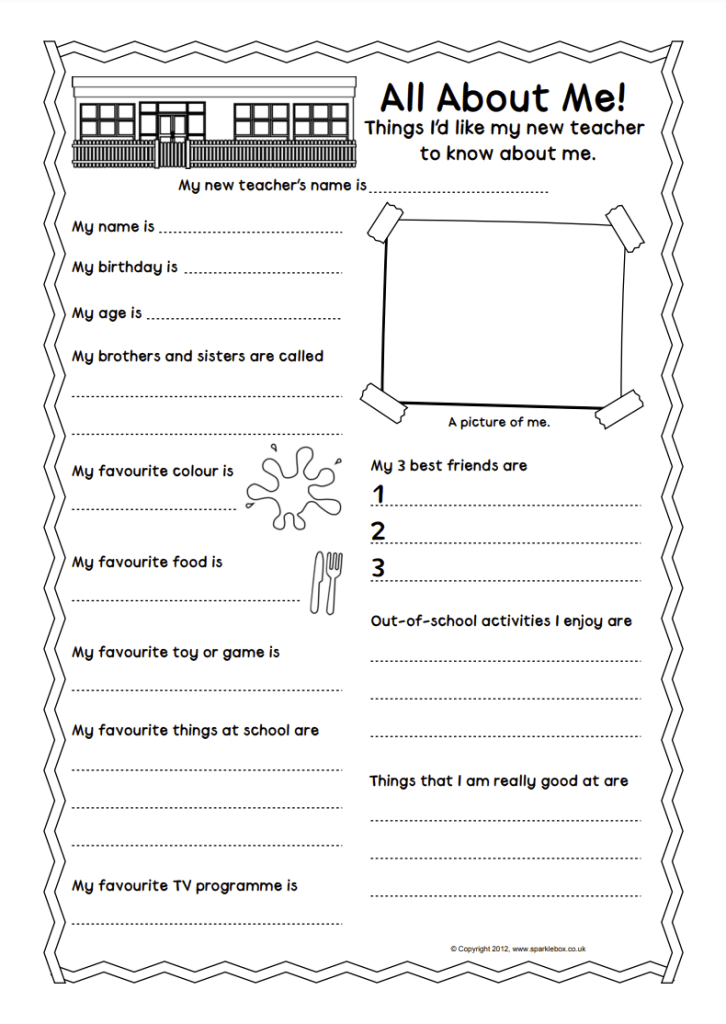
It’s always good to get students to share a bit of themselves with you and their classmates. This free worksheet from Sparklebox is a good starting point.
Back-to-school activities for secondary
First day back KS3 icebreaker activities
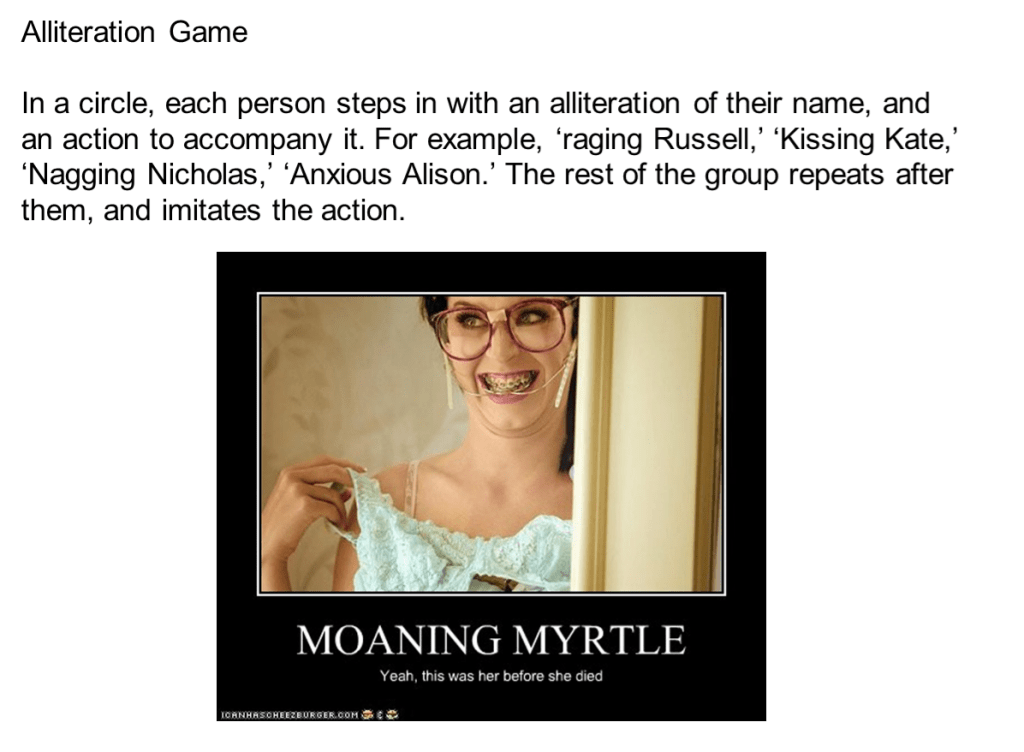
This free PDF features a collection of ways of getting to know your KS3 students and putting them at ease on the first day back in September.
Welcome Back! assembly from TrueTube
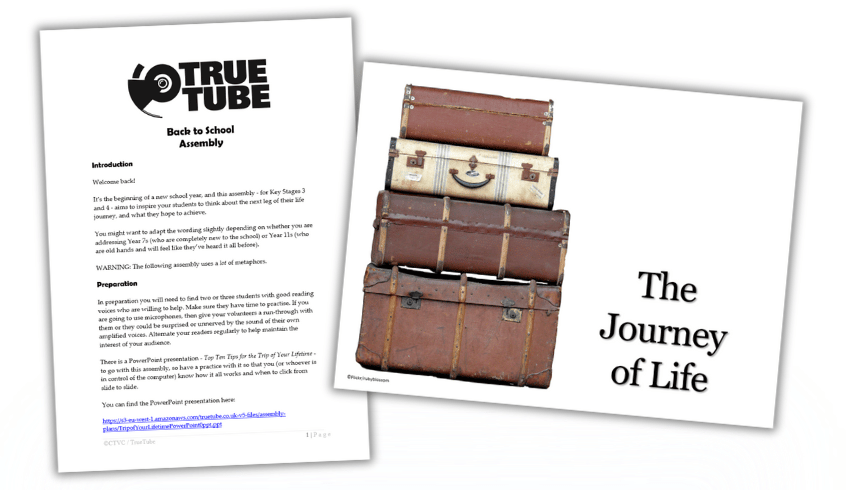
This assembly for Key Stages 3 and 4 will help your students think about what they want to achieve on the next stage of life’s journey. There’s a short film, some games and a PowerPoint presentation too.
Year 7 spellings tracker
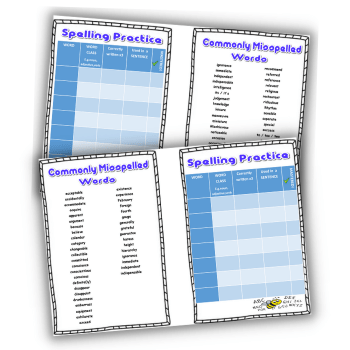
This booklet is designed to help Year 7 students keep track of accurate spellings after responding to feedback in their books.
Simply hole-punch and treasury-tag them at the back of pupils’ exercise books.
Students will find it very useful as it also includes a list of some commonly misspelled words and allows them to independently develop their spelling accuracy.
Caught on film
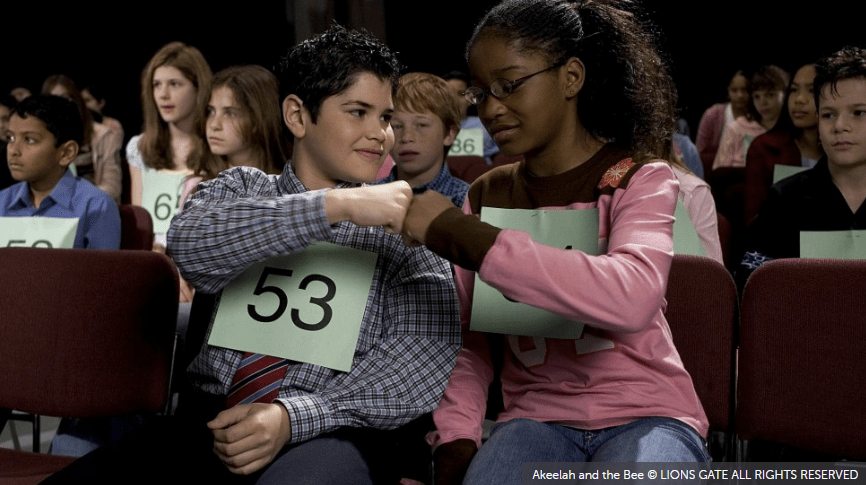
Suitable for primary or secondary teachers, this assembly plan from Into Film makes use of a range of films that look at first days at school, potential problems students may come across and how to tackle them.
Topics included are negotiating the first days, making new friends, believing in yourself and working together. There are also accompanying teachers’ notes on PDF.
Starter activity generator
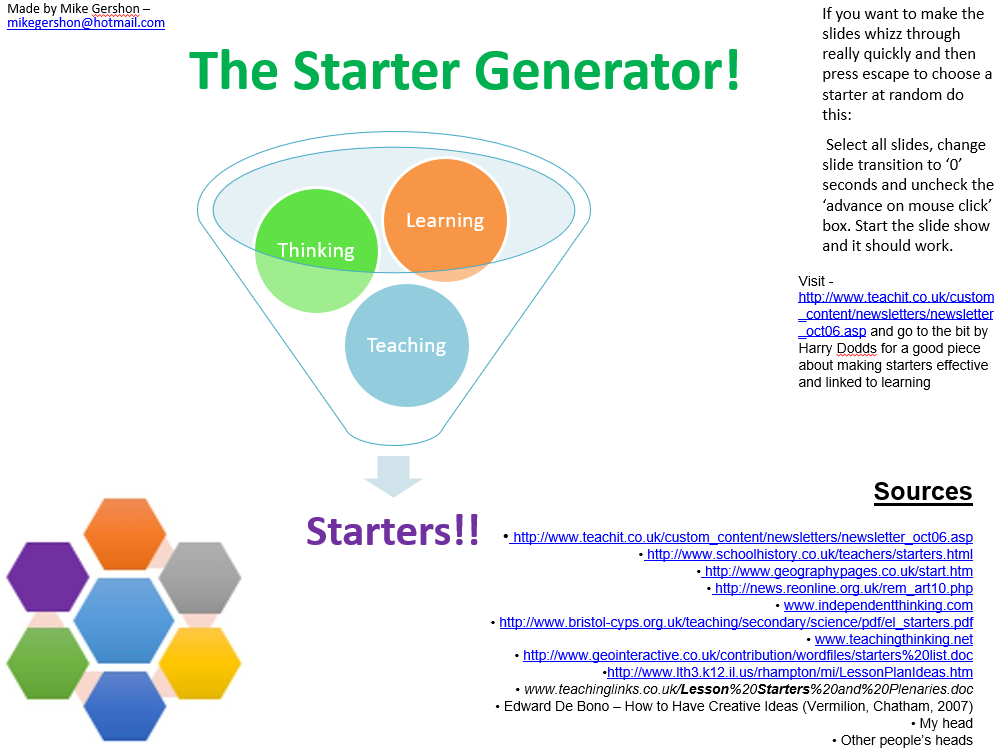
Stocking up on starter activities is always a good idea for the start of a new school year, and you can find over 100 of them in this free activity generator PowerPoint.
Discussion toolkit
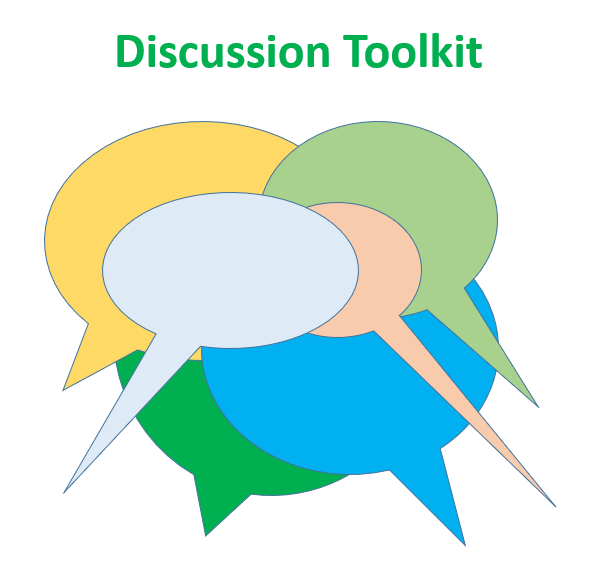
Another of Mike’s excellent resources is this free discussion toolkit PowerPoint. It guides you through a variety of activities you can use to structure and encourage discussion in the classroom.
Given that many of your new students won’t know each other very well, or even at all, these can really help to break the ice in a way that isn’t forced or awkward.
Icebreakers that rock

No one wants to admit the most embarrassing thing they’ve ever done as a forced exercise in a room full of strangers, so these three ideas from Cult of Pedagogy are a much better option.
Described as “no-cheese activities that won’t embarrass students”, they focus on finding similarities and asking hypothetical ‘would you rather…’ questions that get pupils opening up in a safe way.
How to make week one a success in primary

Start as you mean to go on with teacher Sophie Bartlett’s simple advice for getting off on the right foot this term…
Start with a blank slate
Your class’s previous teacher knows them well – make sure you acknowledge, and use, the information they’ve passed on to you about each child.
However, try to filter what is necessary and what isn’t. While one teacher may have found a child ‘difficult’, starting the year with that in mind is setting the relationship up to fail.
Begin with a blank slate and form your own opinions – some children may surprise you!
Vote for a class read
You may already have a book in mind based on your first topic. If so, consider using it the following term (when the children will already have the knowledge of the topic to benefit their understanding of the text – see Doug Lemov’s theory regarding embedding non-fiction).
Instead, allow the class to choose their first text. Teacher Ashley Booth’s ‘World Cup of Books’ idea is great for this: pupils browse a selection of texts and vote in various knockout rounds until a winner has been chosen.
Set expectations
In the last few weeks of summer term – when there are about 57 off-timetable activities going on – you may have let a few things slide (if not, you’re a hero!).
The first day back is the perfect time to remind the children (and yourself!) of how high your expectations are for behaviour, work ethic and presentation.
Ask the children to copy a few sentences out in their neatest handwriting at the start of their book to refer back to throughout the year.
Share your timetable
The first thing my class does each morning is check the day’s timetable. In order to get them organised from the start, share your weekly schedule on the first day back.
It’s also useful to let children know any key dates coming up – parents may already be aware, but children like to know too.
Chat to every child
There are always children who monopolise your attention throughout the day, whether that’s for the right or wrong reasons.
When it gets to lunchtime, check your register and see who you haven’t yet spoken to in the morning. Make a concerted effort to chat to them in the afternoon.
Escape the classroom
It’s highly unlikely you’re going to have any laborious marking to do on the first day, so there is no excuse to stay in the confines of your classroom.
Socialising with other staff is especially important if you are in a new school or have new team members this year. Ask how people’s days are going, offer support and take a break from the classroom – first days are always full of positivity and it’s great to share it!
Befriend your TA
I don’t think any teacher would disagree that our TAs are absolutely invaluable. If you are working with someone new this year, begin forging a positive relationship with them on day one.
Don’t just use them for photocopying and admin. Instead, show the children that you’re a team, and include them in activities. If you’re new to the school, or even the phase, use their knowledge of individual children to your advantage.
Make a seating plan
Start as you mean to go on and put children in set places from the get-go. Personally, I like a mixed ability seating plan.
Last year I showed a random name selector on the board and this picked the order the children sat in. This ensured there was no unconscious bias in choosing where anyone sat and whether they were next to their friends or not.
I told pupils that they were old enough to prove to me that they can be trusted to work sensibly. If not, I would move them. The children loved it and we redo it every half term.
How to make week one a success in secondary
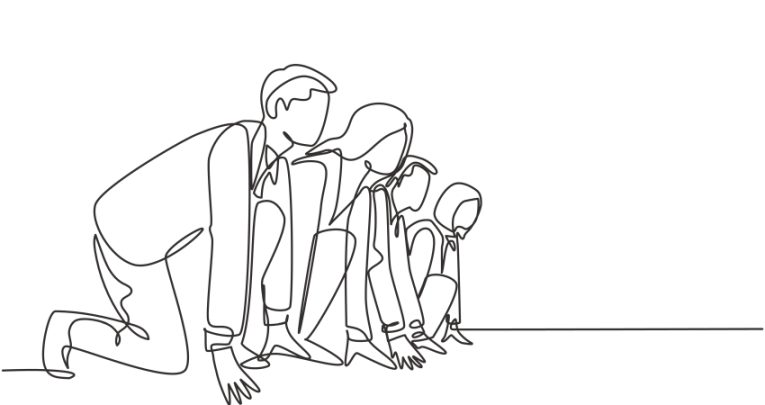
Every teacher knows that in September, incoming cohorts need to settle in and swiftly learn what your expectations are – but it’s a process that can easily go awry, explains head of English Bhamika Bhudia…
Breaking the ice
Getting things right from the offset involves quickly establishing routines and expectations, and minimising any disruption caused by behavioural problems, as students and staff adjust to being back in school after six weeks out of schedule.
Some argue that a standalone lesson on rules, expectations, class contracts and getting-to-know-you icebreaker activities is ideal for this.
The irony of that, however, is that the delivery of this lesson will contradict the consistency you’re trying to establish in the first place.
Yes, rules and expectations must be set, whether in relation to seating, health and safety, behaviour or general admin – but spending an entire lesson on this will convey the opposite message.
Lead through your curriculum
If the aim is to set high expectations of your students, then instead of talking about these expectations, demonstrate them.
Delivering the curriculum is fundamental to the role of the class teacher. With so much content to get through, why waste time talking about your expectations, rather than actually showing them?
Also, those ‘fun’ ice-breaker lessons will not only give a false impression of what your lessons and you as a teacher are like, but will actively undermine your subject.
The curriculum and content itself should be engaging and interesting, so lead with this and focus on imparting love of learning within your subject.
Consistency is key
That old cliché, ‘Don’t smile before Christmas!’ is inherently contradictory. Good relationships are hugely important, particularly in subjects where debate and personal responses will be required.
Deliberately withholding expression or warmth is counterproductive to what you’re trying to achieve, and frankly make your lessons far less enjoyable.
Boundaries need to be set not just up to Christmas, but throughout the entire year – so lay the groundwork from the start.
Be consistent with the behaviour policy, pull up students when they don’t get it right, chase the homeworks and detentions, make the phonecalls and set the detentions where necessary, but build those relationships as well. Fairness and consistency is exactly what students need.
Celebrate the positive
On the flipside, while it’s important to sweat the small stuff when students aren’t getting it right, it’s just as important to celebrate the little wins.
Praise when students are getting things right. Remember that readjusting to regimented school routines after being away from them for a month and a half is tough for everyone involved, so when things are going well, acknowledge it.
Postcards, reward stickers and positive phone calls are all vital parts of any teacher’s toolkit, and should be used effectively.
Again, consistency is key here – don’t just do it for a month and then let everything fall by the wayside. Start as you mean to go on. Your students will only meet the expectations you continue to set, and if you slack, so will they.
Watch the pressure
It’s easy to forget that our new Y7s, Y10s and Y12s are simply Y6s, Y9s and Y11s plus an extra six weeks, so don’t expect any magical transformations.
Moving school or up a Key Stage can be an overwhelming transition for many students. While the stakes are much higher on the other side of summer, remember that yours isn’t their only ‘first’ lesson of the week.
The coming year will doubtless be one that’s important and consequential for them, but experiencing that same messaging from teachers over the course of ten lessons within the same week can be overwhelming for many.
Once again, setting high expectations through your teaching is far more effective than hammering this point through words alone. Give your Y7s reminders before they get things wrong; don’t expect your Y10s to have matured overnight; and don’t throw your Y12s in at the deep end.
High challenge and high expectations are necessary, but be ready to guide them to where they need to be through your teaching.
10 behaviour ‘do nots’ for the new year

Start as you mean to go on and get behaviour management right with your class from day one by following these ten ‘don’ts’ from Robin Launder…
1 Never shout
Shouting is just plain wrong – and that’s reason enough why you should never do it in the classroom. But it’s also counterproductive, often generating more student misbehaviour, not less.
Sure, in the very short term, shouting might bring children into line. But the pupils soon get used to your raised voice. In an attempt to recapture that initial success, you shout louder and more frequently, but that ends up as white noise. Soon, it all spirals out of control. So never shout, OK?
It’s important to note, though, that raising your voice to get student attention is not the same as shouting. Just make sure there’s no anger or other negative emotion involved.
2 Never humiliate
Humiliating students, like shouting at them, is unethical and self-defeating. It’s simple really: humiliate a student and they will not like you, which means they won’t work for you – or at least they won’t work as hard for you as they could.
“Humiliate a student and they will not like you, which means they won’t work for you”
In fact, because of the sting of that humiliation, they might even work against you, try to undermine you in some way and attempt to get their own back on you.
Also, don’t be sarcastic, don’t lecture and don’t make a joke at a student’s expense.
3 Never say please
Instead of saying ‘please’, say ‘thank you’. Thank you and please are equally as respectful, but please implies you are begging for student compliance, whereas thank you sends the message that what you want to happen will happen – because otherwise, why would you be thanking them?
4 Never argue
Arguing doesn’t resolve situations – in fact, it entrenches positions. Not only that, an argument can quickly turn into a shouting match, and when that happens, everyone loses – you, the pupil, and all the children witnessing the exchange. So avoid arguing at all costs.
“An argument can quickly turn into a shouting match”
If a student wants to engage you in an argument, tell them that you’re happy to have a chat at the end of the lesson. Be genuine in this offer, too.
That said, when the end of the lesson comes, most pupils will no longer need to talk to you, and even if they do, they (and you) will be much calmer.
Oh, and there won’t be any audience present to inflame the situation.
5 Never praise students for the things they should be doing
If you do, you will be lowering the bar of your expectations when you should be raising it. You’ll be communicating that doing the everyday and the commonplace is noteworthy of extra and special attention, when it’s not.
What’s worthy of extra and special attention is extra and special behaviour. Sure, a polite ‘thank you’ or non-verbal acknowledgement is fine, but anything beyond that is counterproductive – and, frankly, a bit needy.
6 Never turn a blind eye
Don’t do it in your classroom, don’t do it in the corridors, and don’t do it in the playground. In fact, don’t do it anywhere.
If you pretend that you didn’t see something when you did, the students will conclude that either a) you are scared of dealing with the misbehaviour, or b) you are a bit inept. Either way, they’ll realise that they will be able to get away with loads.
7 Never break your word
What you say and what you do must be one and the same thing. If what you say is the same as what you do, then what you say will carry the weight of what you do. So, no idle ultimatums, no broken promises.
If you say you are going to speak to a pupil at break, be in your classroom waiting. If you say you are going to issue a consequence, issue it. Said you’re going to the school play on Thursday night? Go to the school play on Thursday night.
If, for some out-of-the-blue reason, you can’t do what you said you are going to do, address it with the pupil at the next opportunity – oh, and be doubly sure that you don’t break your word again with them.
8 Never send a child out into the corridor
The pupil is misbehaving. You’ve given him or her chances. You’ve gone through your range of behaviour interventions and – argh! – still they’re mucking around. So you play your get-out-of-jail-free card and kick ’em out. Problem solved.
Except it isn’t. At best it’s been delayed and quite likely worsened. The student still has to come back into the lesson – assuming he or she hasn’t wandered off and is causing mischief somewhere else in the school.
Worse, you now know what to do if this pupil misbehaves again: you kick ’em out. Which means, guess what, you are much more likely to kick ’em out again.
And every time you do, the effectiveness of the strategy – assuming it was ever effective – reduces.
Then there’s all your other children. Every time you send a pupil into the corridor, you are communicating to your class that you do not have the skills to deal with misbehaviour effectively: to avert it, to manage it, to de-escalate it.
Hence, your standing in the eyes of classroom falls, to the point that the children who are normally well behaved might themselves begin to misbehave. So now you kick out even more students.
9 Never have favourites
Or, if you like, have every student as your favourite. Children will quickly spot preferential treatment and rebel against it.
10 Never take pupil misbehaviour personally
If you do, it will get under your skin and wind you up. Instead, view misbehaviour as a learning opportunity.
If pupils get a sum wrong, or misspell a word or don’t know their gluteus maximus from their elbow, you, as the teacher, would see that as a learning opportunity.
So it is with misbehaviour; it’s a mistake that can be learned from – and if you view it that way, the student will be more likely to as well.
Robin Launder is the director of Behaviour Buddy, a company that specialises in evidence based CPD, including behaviour management CPD. He tweets at @behaviourbuddy.










